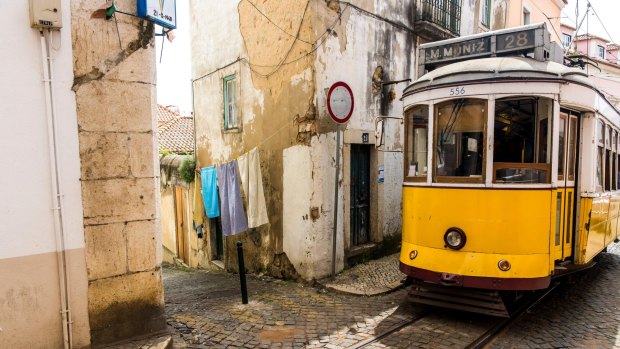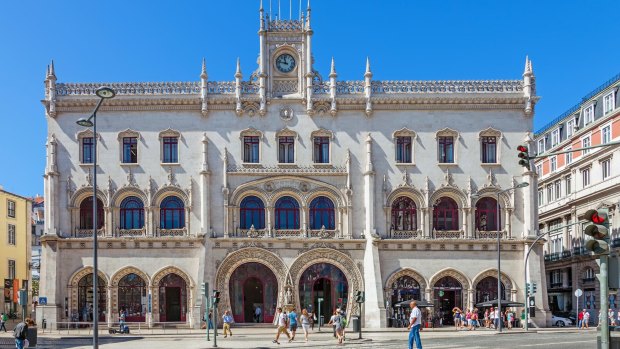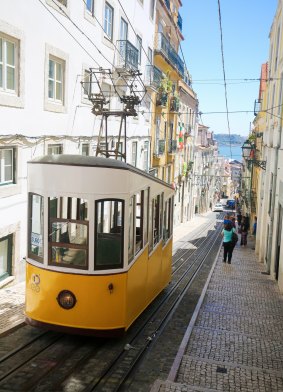This was published 6 years ago
Lisbon, Portugal: Riding the hilly city's historic trams is an essential traveller's experience
By David McGonigal

Lisbon's classic No. 28 tram en route through the Alfama district.Credit: Alamy
There is a special transport link between Melbourne and Lisbon. In the 1986 Australian cult comedy film Malcolm, Colin Friels' character utilises Melbourne's trams for an entertaining heist. At the end of the film we see our protagonists ready to strike again on Lisbon's undulating tram network.
Lisbon locals today will warn you that the No. 28 tram has its own larceny as it weaves a convoluted path around Lisbon, crowded with tourists and pickpockets. However, public transport in Lisbon remains especially appealing as the tram shares its uplifting ways with several funiculars, a beautiful train station and an outdoor cast-iron lift reminiscent of the Eiffel Tower.
ASCENSOR DO LAVRA

The Rossio Railway Station.Credit: Alamy
Hilly Lisbon began its romance with the funicular when the Ascensor do Lavra began operation in 1884. It runs between Largo da Anunciada down on the city level known as Baixa, and Travessa Forno Torel up the hill. Originally powered by a water counterweight it switched to steam before being electrified in 1915. The two quaint yellow-and-white, 42-passenger cars trundle up and down its short, 188-metre-long journey along a steep 25 per cent incline for about 12 hours each day. At the top it's only a short walk to Jardim do Torel, a park with good views over the city.
As it is slightly out of the way, this is the easiest funicular in Lisbon to ride without a wait. On a mid-summer morning we were the only passengers on board.
ASCENSOR DA GLORIA

The Ascensor da Gloria in Bairro Alto.Credit: Alamy
On the other side of the grand boulevard of Avenida da Liberdade (and climbing another of Lisbon's seven hills) is the Ascensor da Gloria that rises from sea-level Restauradores Square in Baixa to Bairro Alto. Located along one of the most frequented areas of Lisbon, it even featured in a 1980s pop song (sadly, not Van Morrison's Gloria). It, too, ends near a park but there's also a booming restaurant scene up here.
Ascensor da Gloria opened in 1885 as Lisbon's second funicular and has also evolved through water and steam power to electricity today. In the early days the cars had open-air top decks but today there's only the 42-passenger, closed carriage with rather uncomfortable benches running along each side.
ROSSIO RAILWAY STATION
From a distance, this ornate building appears much more likely to be a palace than a transport hub. However, the elaborate facade dominated by two Moorish horseshoe arches (a style that dates back more than 1500 years) and a clock turret, leads to a modern functional train station inside. When it opened in 1890 it was Lisbon's Central Station but it now serves only as a departure point for trains to the picturesque town of Sintra, 27 kilometres away.
The escalators inside the station are a convenient and free way to ascend the same hill as the Gloria funicular. Downtown Lisbon is quite compact so it's worth visiting Rossio Station in the evening when the facade is illuminated in all its glory. There's a gory element, too: in 1918, Sidonio Pais, the fourth president of Portugal, was shot inside Rossio station after dining in town before taking a train to Porto. The president died that night while his assassin died in a psychiatric hospital in 1946.
ELEVADOR DE SANTA JUSTA
It may relate back to the early Australian suburban love of filigree wrought iron but I consider the Santa Justa lift, like the Eiffel Tower, to be a standout urban attraction. It's a neo-Gothic tower with a practical purpose – lifting people up 45 metres from the shopping strip of Rua Aurea to the equally busy shopping area of Largo do Carmo.
As practical transport it's hopeless because there's always a long line of tourists waiting to board one of the two polished wood carriages. As a tourist activity, however, it's a brief highlight (plus extensive waiting time). At the top there's a viewing platform that reveals a panorama across the Baixa district to the Moorish San Jorge castle on the opposite hill.
The Santa Justa lift was inaugurated by King Carlos in 1901 but didn't commence operation until 1902. It was designed by the engineer and architect Raoul Mesnier de Ponsard, from Porto, who was Portuguese of French parents and also designed the Gloria and Bica ascensors. It switched from steam to electricity in 1907. Just about every tourist brochure claims that Raoul was a student/disciple/apprentice of Gustave Eiffel but I can't find any evidence that such a claim is true. Both landmarks, however, are elaborate symphonies in metal.
An outdoor lift may seem unusual but the alternative of slogging uphill in a Lisbon summer makes the wait worthwhile. It runs from 7am to 11pm each day (closing at 9pm in winter). At the summit, take time to examine the elaborate wrought iron surrounding the viewing platforms and the walkway to the street.
ASCENSOR DA BICA
Most of Lisbon's means of elevation are visible and easily found, this one isn't. Indeed, the Time Out Market is one of the most popular places for visitors to Lisbon looking for good food but many may miss the Ascensor da Bica just a few steps away behind a wall on Rua de San Paulo.
Ironically, while the access may be hidden, this is regarded as Lisbon's most picturesque route, travelling along narrow Rua da Bica de Duarte Belo, past bars and cafes to Largo Calhariz. You feel as if you could reach out the carriage window to collect your coffee from the counter as you pass by classic Lisbon streetscapes.
Bica started operation in 1892 powered by steam and switched to electricity in 1914. The two Bica carriages are stepped into three separate areas, each with its own doorway, and each can carry 23 passengers including nine seated.
NO. 28 TRAM
In the 1990s, Carris, whichprovides Lisbon's public transport, decided to renovate 45 of its traditional wooden trams and fitted them with modern electro-mechanical technology. Today, those character-filled trams are part of the fabric of the Lisbon travel experience.
Most famous is the No. 28 tram, which plies a 10-kilometre route from Graca to Prazeres, passing many of the city's main attractions along the way. There's generally a crowd waiting to board at Praca Martim Moniz but there's a tram every few minutes so you just have to be patient.
Only a few minutes into the journey the tram winds up into the Alfama hills through narrow streets where, at some points, there is not enough space between home and tram for a person to stand. Much of Lisbon was destroyed by the Great Earthquake of 1755 (followed by a tsunami and widespread fires) but the Alfama sits on a solid rock that escaped the catastrophic damage elsewhere. As a consequence, it's here that you see Lisbon's traditional tiled buildings and labyrinth-like neighbourhoods. It's the most dramatic part of the No. 28 route.
The sound of the tram turning tight corners and its frequently employed bell to remind people to get out of the way ensures you feel involved throughout. As stated earlier, because it is a world-famous ride it also attracts thieves looking for easy targets, so travel with a minimum of cash and valuables.
After crossing back through downtown the tram climbs up into Chiado and Estrela then eventually arrives at Lisbon's largest cemetery, the Cemiterio dos Prazeres or the Cemetery of Pleasures. It's the end of the line indeed. While it takes its strange name from the neighbourhood there's some pleasure in exploring the cemetery to observe its impressive mausoleums and the resting place of the famous who are buried here.
The last scene of Malcolm shows Malcolm, Frank and Judith watching a No. 28 tram winding through Lisbon. The various forms of unique transport adds a lot to the city's appeal.
FLY
Emirates offers more than 20 flights each week between Sydney or Melbourne and Lisbon with a single stop in Dubai. See emirates.com
STAY
The Sofitel Lisbon Liberdade is centrally situated on the grand and stylish Avenida da Liberdade with room rates from $270 per night. See sofitel-lisbon-liberdade.com
TIP
If you pay on board it costs €3 on the tram and €3.80 and €5.30 on the funiculars and lift respectively. These are all part of the Carris network so it is much better value to buy a 24-hour network ticket at any metro station. This allows you to travel on all of these as well as the tram to Belem.
Sign up for the Traveller Deals newsletter
Get exclusive travel deals delivered straight to your inbox. Sign up now.